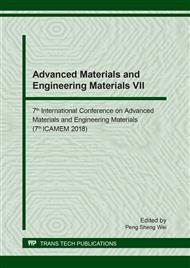p.426
p.432
p.438
p.446
p.451
p.457
p.465
p.471
p.476
Application of GTN Model in Tensile Fracture of Pipeline Steel
Abstract:
In this paper, the macroscopic mechanical behavior of tensile fracture of X70 pipeline steel is combined with the evolution of mesoscopic pores. The ABAQUS finite element software was used to analyze the variation of pore volume fraction in the tensile failure process of unilateral notched specimens with Gurson-Tvergaard-Needleman (GTN) mesoscopic damage model. Combined with the unilateral notched tensile test and the numerical simulation results, the damage mechanics model of pipeline steel based on void volume fraction is established. The results show that the volume fraction of pores is a mesomechanical parameter based on the damage of the micro-holes in the metallic plastic material, which is a bridge between the mesoscopic damage characteristics and the macro-mechanical parameters. Establishing the damage mechanics model of high strength pipeline steel with hole volume fraction as damage variable can truly reflect the macro-meso-mechanics behavior of X70 pipeline steel during unilateral notching.
Info:
Periodical:
Pages:
451-456
Citation:
Online since:
August 2018
Authors:
Price:
Сopyright:
© 2018 Trans Tech Publications Ltd. All Rights Reserved
Share:
Citation:


